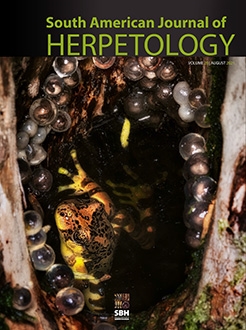We investigated daily activity, microhabitat use, and feeding habits of the anuran Adenomera marmorata in two Brazilian Atlantic forest remnants: Estação Ecológica Estadual Paraíso (EEEP) and Reserva Ecológica de Guapiaçu (REGUA). Most individuals were active at dusk (EEEP: n = 5 or 62.5%; REGUA: n = 16 or 45.7%; populations pooled: n = 21 or 48.8%) and nocturnally (EEEP: n = 3 or 37.5%; REGUA: n = 17 or 48.6%; populations pooled: n = 20 or 46.5%); however, individuals were encountered during the day (EEEP: n = 0; REGUA: n = 2 or 5.7%; populations pooled: n = 2 or 4.7%). The microhabitat used most by the anurans was the leaf litter of forest floor (EEEP: n = 8 or 80.0%; REGUA: n = 33 or 94.3%; populations pooled: n = 41 or 91.1%). In EEEP, in numerical terms, mainly isopods (33.33%) and ants (22.22%) composed the diet of A. marmorata. Volumetrically, Isopoda (77.37%) was the most important item. In terms of frequency of occurrence, isopods, and ants, both consumed by 30% of the individuals, were the most relevant food items. In REGUA, numerically, individuals mainly consumed ants (23.26%) and isopods (20.93%). In volumetric terms, individuals predominantly ingested isopods (56.57%). The food items most commonly consumed by individuals in REGUA were isopods (40.63%) and ants (37.50%). Adenomera marmorata ingested 8 different types of food in EEEP and 14 in REGUA, feeding on a significantly higher number of food items in REGUA than in EEEP. The populations also differed in diet composition in volumetric terms, showing that food consumption can vary between populations, which might result from differences in local food availability and individual morphological characteristics. Adenomera marmorata might be able to forage opportunistically or selectively depending on the prey.
How to translate text using browser tools
31 August 2021
Feeding Habits, Microhabitat Use, and Daily Activity Cycle of Adenomera marmorata (Anura, Leptodactylidae) in Two Brazilian Atlantic Forest Remnants
Thiago Maia-Carneiro,
Thiago Arnt Dorigo,
Mara Cíntia Kiefer,
Monique Van Sluys,
Carlos Frederico Duarte Rocha
ACCESS THE FULL ARTICLE
<
Previous Article
|
diet
food niche
Space niche
space use
Time niche





